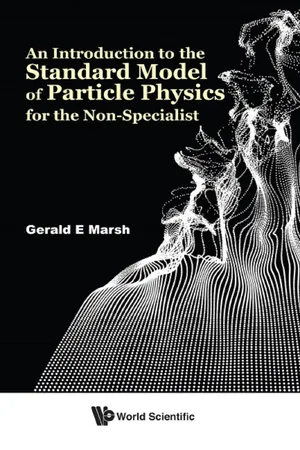
An Introduction to the Standard Model of Particle Physics for the Non-Specialist
Gerald E Marsh
- 164 Seiten
- English
- ePUB (handyfreundlich)
- Über iOS und Android verfügbar
An Introduction to the Standard Model of Particle Physics for the Non-Specialist
Gerald E Marsh
Über dieses Buch
-->
This book takes the reader from some elementary ideas about groups to the essence of the Standard Model of particle physics along a relatively straight and intuitive path. Groups alone are first used to arrive at a classical analog of the Dirac equation. Using elementary quantum mechanics, this analog can be turned into the actual Dirac equation, which governs the motion of the quarks and leptons of the Standard Model. After an introduction to the gauge principle, the groups introduced in the beginning of the book are used to give an introduction to the Standard Model. The idea is to give an Olympian view of this evolution, one that is often missing when absorbing the detailed subject matter of the Standard Model as presented in an historical approach to the subject.
--> Contents:
- Preface
- Groups
- A Semblance of the Dirac Equation From Groups
- Minimalist Quantum Mechanics
- Gauge Principle
- Standard Model Beginnings
- Particles of the Standard Model and QCD
- Appendix A: The Particle Enigma
- Appendix B: Spinor Representations of the Lorentz Group
- Appendix C: The Schwinger Term
- Appendix D: The Cosmic Microwave Background Radiation
- A Few Reference Books
- Index
-->
--> Readership: Undergraduate students and academics interested in the Standard Model. -->
Keywords:Standard Model?? Particle Physics;Standard Model?? QCDReview: Key Features:
- Presents the Standard Model not only using an historical approach, but also with some philosophical aspects, discussing some recent research on the nature of a "particle"
Häufig gestellte Fragen
Information
Appendix A: The Particle Enigma
A1. The de Broglie Relation: Theory and Experiment



Inhaltsverzeichnis
- Cover
- Halftitle
- Title
- Copyright
- Dedication
- Preface
- Contents
- Groups
- A Semblance of the Dirac Equation From Groups
- Minimalist Quantum Mechanics
- Gauge Principle
- Standard Model Beginnings
- Particles of the Standard Model and QCD
- Appendix A: The Particle Enigma
- Appendix B: Spinor Representations of the Lorentz Group
- Appendix C: The Schwinger Term
- Appendix D: The Cosmic Microwave Background Radiation
- A Few Reference Books
- Index